Abstract
Helicobacter pylori infection of the stomach is accompanied by a persistent polymorphonuclear leukocyte (PMNL) infiltrate of the mucosa. The aim of this work was to study the activation of human PMNL by substances produced by H pylori. Filtered H pylori conditioned media stimulated a significant PMNL oxidative burst (p less than 0.002). This was equal to 26% of the maximal response stimulated by the PMNL chemotactic peptide N-formyl-methionyl-leucyl-phenylalanine (FMLP, 1 mumol/l). The response to FMLP was prolonged by the combined presence of complement inactivated human anti-H pylori plasma and conditioned medium (p less than 0.002). High pressure liquid chromatography of an extract of conditioned medium showed a fraction that stimulated PMNL, eluted, and antigenically cross reacted with FMLP. Washed H pylori cells, and those opsonised with complement inactivated human anti-H pylori plasma, did not induce a significant oxidative burst. Opsonized H pylori, however, prolonged the oxidative burst induced by FMLP (p less than 0.02). In conclusion, H pylori synthesizes and secretes a substance, probably FMLP, that may account for the PMNL accumulation that accompanies H pylori infections. Immune complexes composed of H pylori antigen and specific antibody potentiate the PMNL oxidative burst. This combination of H pylori derived products, and host PMNL and antibodies, may be involved in the mucosal damage observed in H pylori associated gastritis.
Full text
PDF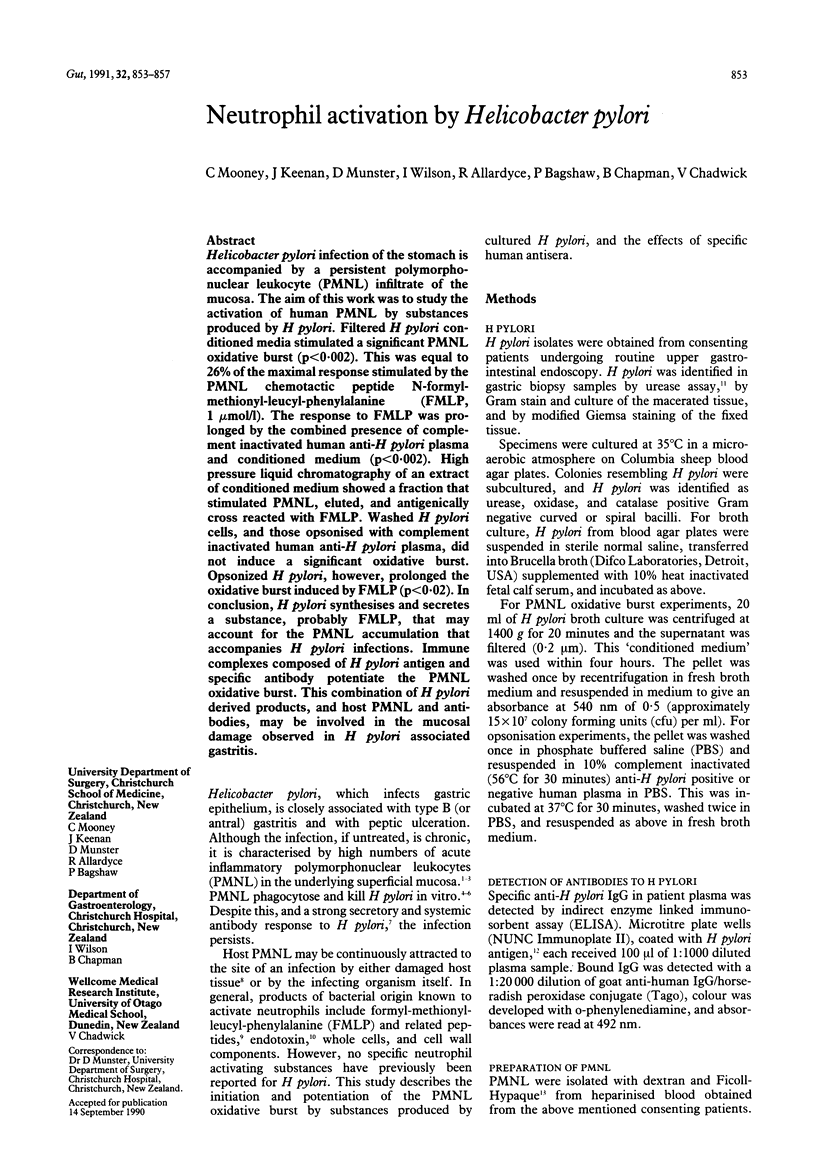
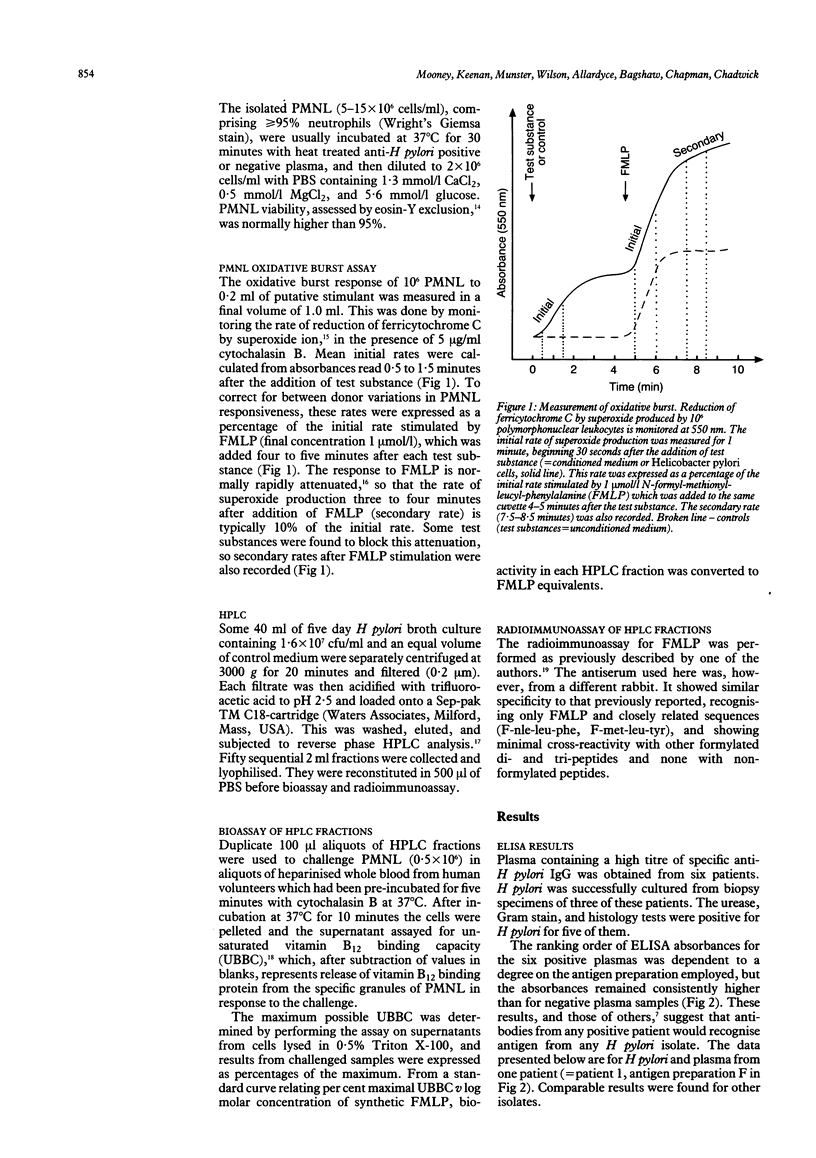
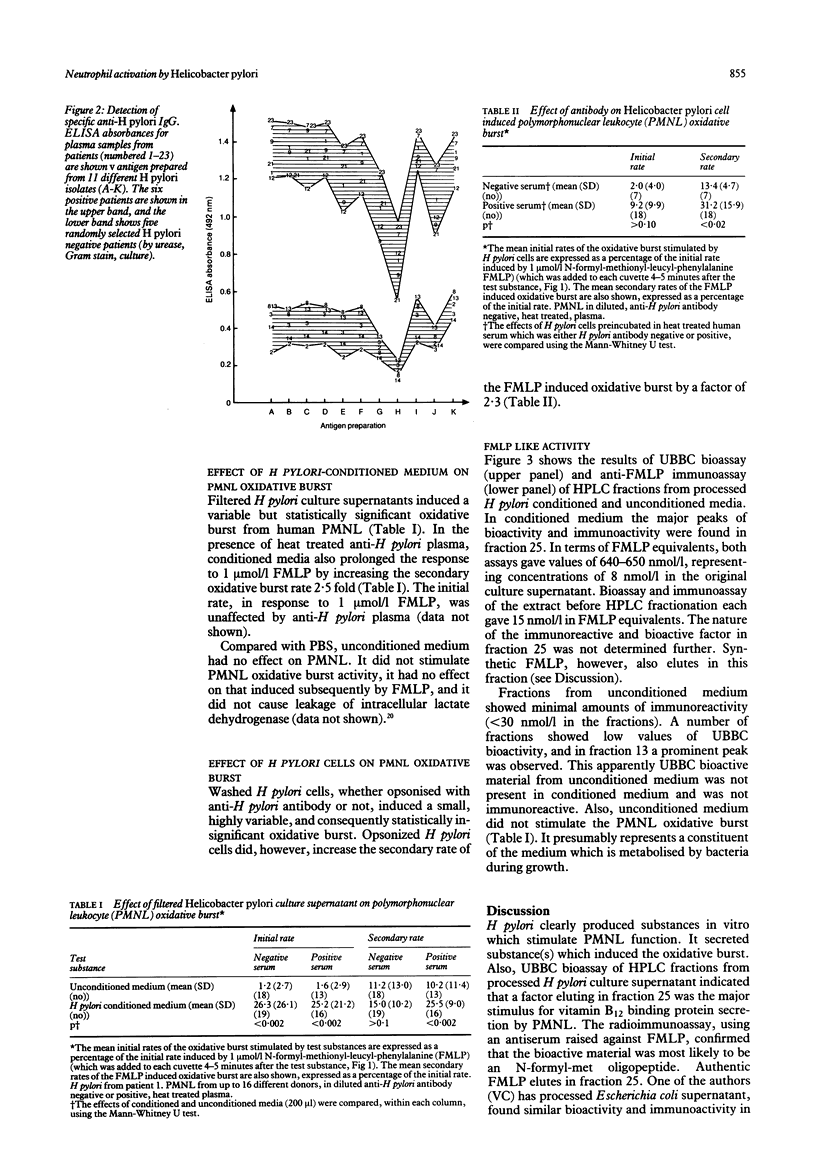
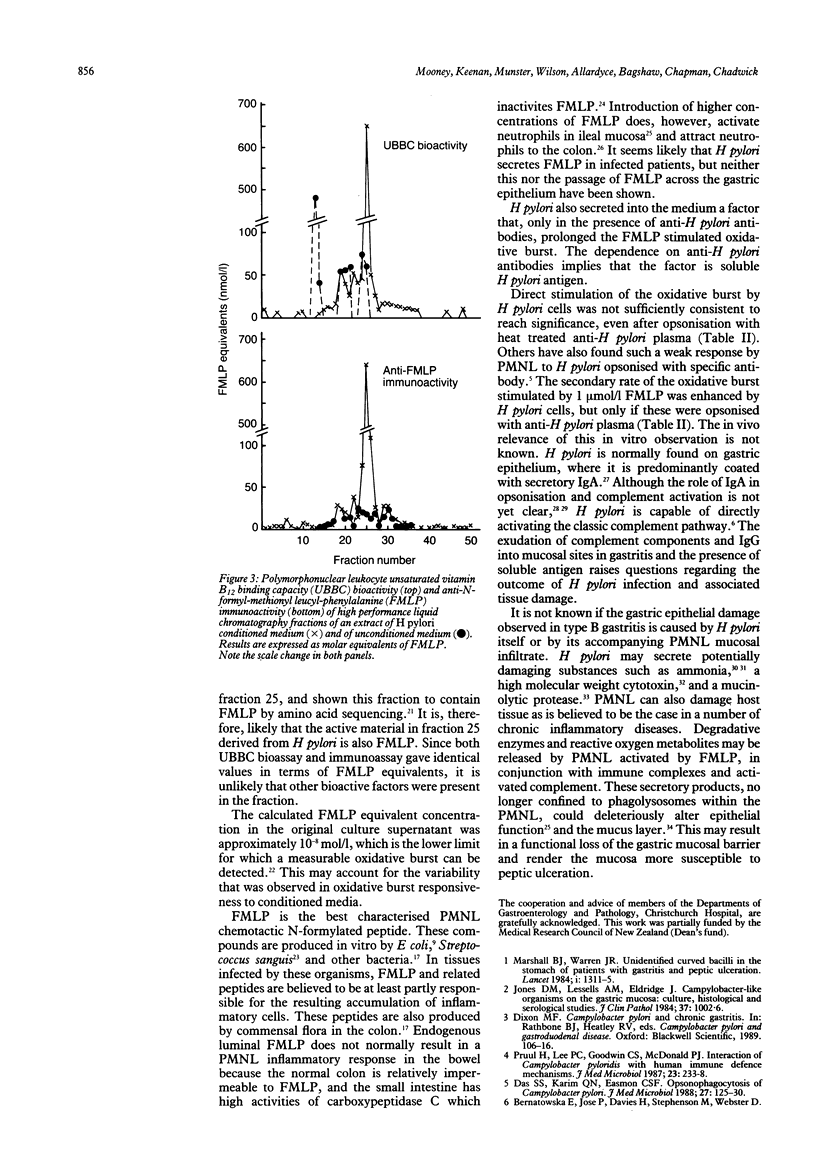
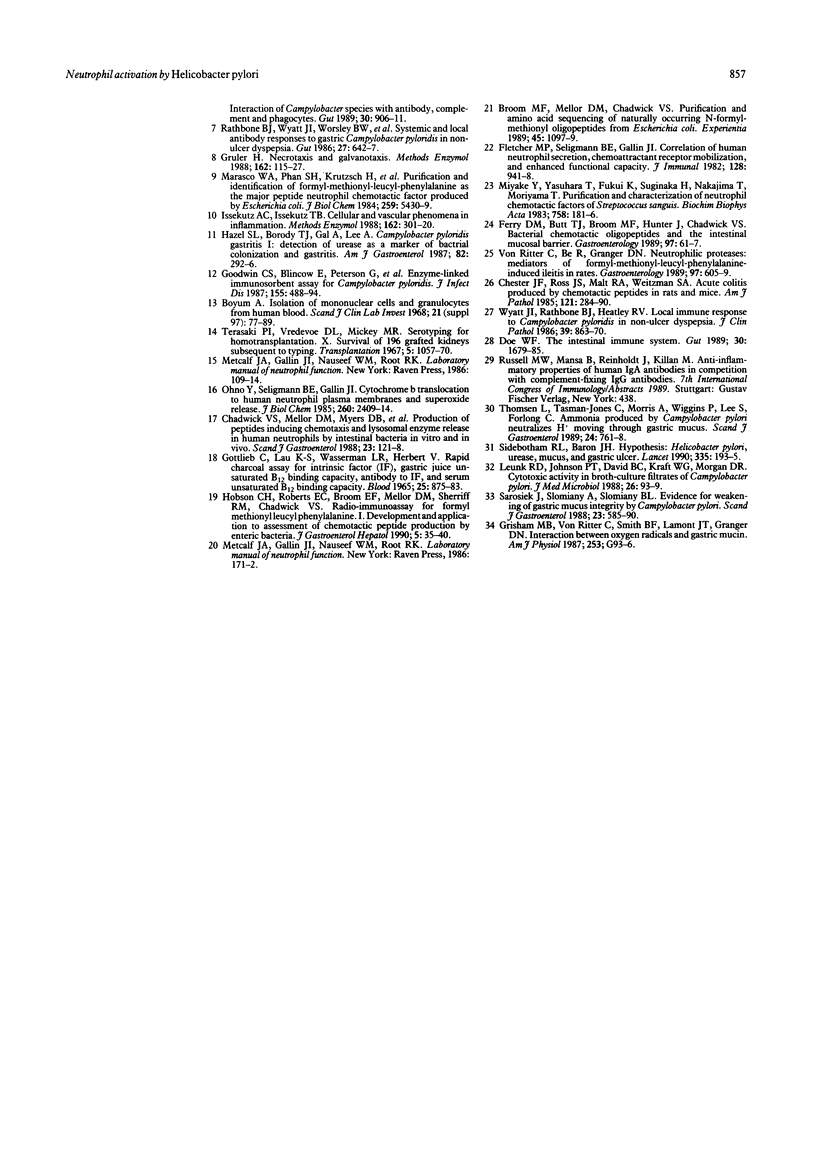
Selected References
These references are in PubMed. This may not be the complete list of references from this article.
- Bernatowska E., Jose P., Davies H., Stephenson M., Webster D. Interaction of campylobacter species with antibody, complement and phagocytes. Gut. 1989 Jul;30(7):906–911. doi: 10.1136/gut.30.7.906. [DOI] [PMC free article] [PubMed] [Google Scholar]
- Broom M. F., Mellor D. M., Chadwick V. S. Purification and amino acid sequencing of naturally occurring N-formyl-methionyl oligopeptides from Escherichia coli. Experientia. 1989 Dec 1;45(11-12):1097–1099. doi: 10.1007/BF01950167. [DOI] [PubMed] [Google Scholar]
- Chadwick V. S., Mellor D. M., Myers D. B., Selden A. C., Keshavarzian A., Broom M. F., Hobson C. H. Production of peptides inducing chemotaxis and lysosomal enzyme release in human neutrophils by intestinal bacteria in vitro and in vivo. Scand J Gastroenterol. 1988 Jan;23(1):121–128. doi: 10.3109/00365528809093861. [DOI] [PubMed] [Google Scholar]
- Chester J. F., Ross J. S., Malt R. A., Weitzman S. A. Acute colitis produced by chemotactic peptides in rats and mice. Am J Pathol. 1985 Nov;121(2):284–290. [PMC free article] [PubMed] [Google Scholar]
- Das S. S., Karim Q. N., Easmon C. S. Opsonophagocytosis of Campylobacter pylori. J Med Microbiol. 1988 Oct;27(2):125–130. doi: 10.1099/00222615-27-2-125. [DOI] [PubMed] [Google Scholar]
- Doe W. F. The intestinal immune system. Gut. 1989 Dec;30(12):1679–1685. doi: 10.1136/gut.30.12.1679. [DOI] [PMC free article] [PubMed] [Google Scholar]
- Ferry D. M., Butt T. J., Broom M. F., Hunter J., Chadwick V. S. Bacterial chemotactic oligopeptides and the intestinal mucosal barrier. Gastroenterology. 1989 Jul;97(1):61–67. doi: 10.1016/0016-5085(89)91416-9. [DOI] [PubMed] [Google Scholar]
- Fletcher M. P., Seligmann B. E., Gallin J. I. Correlation of human neutrophil secretion, chemoattractant receptor mobilization, and enhanced functional capacity. J Immunol. 1982 Feb;128(2):941–948. [PubMed] [Google Scholar]
- Goodwin C. S., Blincow E., Peterson G., Sanderson C., Cheng W., Marshall B., Warren J. R., McCulloch R. Enzyme-linked immunosorbent assay for Campylobacter pyloridis: correlation with presence of C. pyloridis in the gastric mucosa. J Infect Dis. 1987 Mar;155(3):488–494. doi: 10.1093/infdis/155.3.488. [DOI] [PubMed] [Google Scholar]
- Gruler H. Necrotaxis and galvanotaxis. Methods Enzymol. 1988;162:115–127. doi: 10.1016/0076-6879(88)62069-6. [DOI] [PubMed] [Google Scholar]
- Hazell S. L., Borody T. J., Gal A., Lee A. Campylobacter pyloridis gastritis I: Detection of urease as a marker of bacterial colonization and gastritis. Am J Gastroenterol. 1987 Apr;82(4):292–296. [PubMed] [Google Scholar]
- Issekutz A. C., Issekutz T. B. Cellular and vascular phenomena in inflammation. Methods Enzymol. 1988;162:301–320. doi: 10.1016/0076-6879(88)62085-4. [DOI] [PubMed] [Google Scholar]
- Jones D. M., Lessells A. M., Eldridge J. Campylobacter like organisms on the gastric mucosa: culture, histological, and serological studies. J Clin Pathol. 1984 Sep;37(9):1002–1006. doi: 10.1136/jcp.37.9.1002. [DOI] [PMC free article] [PubMed] [Google Scholar]
- Leunk R. D., Johnson P. T., David B. C., Kraft W. G., Morgan D. R. Cytotoxic activity in broth-culture filtrates of Campylobacter pylori. J Med Microbiol. 1988 Jun;26(2):93–99. doi: 10.1099/00222615-26-2-93. [DOI] [PubMed] [Google Scholar]
- Marasco W. A., Phan S. H., Krutzsch H., Showell H. J., Feltner D. E., Nairn R., Becker E. L., Ward P. A. Purification and identification of formyl-methionyl-leucyl-phenylalanine as the major peptide neutrophil chemotactic factor produced by Escherichia coli. J Biol Chem. 1984 May 10;259(9):5430–5439. [PubMed] [Google Scholar]
- Marshall B. J., Warren J. R. Unidentified curved bacilli in the stomach of patients with gastritis and peptic ulceration. Lancet. 1984 Jun 16;1(8390):1311–1315. doi: 10.1016/s0140-6736(84)91816-6. [DOI] [PubMed] [Google Scholar]
- Miyake Y., Yasuhara T., Fukui K., Suginaka H., Nakajima T., Moriyama T. Purification and characterization of neutrophil chemotactic factors of Streptococcus sanguis. Biochim Biophys Acta. 1983 Jul 29;758(2):181–186. doi: 10.1016/0304-4165(83)90300-8. [DOI] [PubMed] [Google Scholar]
- Ohno Y., Seligmann B. E., Gallin J. I. Cytochrome b translocation to human neutrophil plasma membranes and superoxide release. Differential effects of N-formylmethionylleucylphenylalanine, phorbol myristate acetate, and A23187. J Biol Chem. 1985 Feb 25;260(4):2409–2414. [PubMed] [Google Scholar]
- Pruul H., Lee P. C., Goodwin C. S., McDonald P. J. Interaction of Campylobacter pyloridis with human immune defence mechanisms. J Med Microbiol. 1987 May;23(3):233–238. doi: 10.1099/00222615-23-3-233. [DOI] [PubMed] [Google Scholar]
- Rathbone B. J., Wyatt J. I., Worsley B. W., Shires S. E., Trejdosiewicz L. K., Heatley R. V., Losowsky M. S. Systemic and local antibody responses to gastric Campylobacter pyloridis in non-ulcer dyspepsia. Gut. 1986 Jun;27(6):642–647. doi: 10.1136/gut.27.6.642. [DOI] [PMC free article] [PubMed] [Google Scholar]
- Sarosiek J., Slomiany A., Slomiany B. L. Evidence for weakening of gastric mucus integrity by Campylobacter pylori. Scand J Gastroenterol. 1988 Jun;23(5):585–590. doi: 10.3109/00365528809093916. [DOI] [PubMed] [Google Scholar]
- Sidebotham R. L., Baron J. H. Hypothesis: Helicobacter pylori, urease, mucus, and gastric ulcer. Lancet. 1990 Jan 27;335(8683):193–195. doi: 10.1016/0140-6736(90)90279-e. [DOI] [PubMed] [Google Scholar]
- Terasaki P. I., Vredevoe D. L., Mickey M. R. Serotyping for homotransplantation. X. Survival of 196 grafted kidneys subsequent to typing. Transplantation. 1967 Jul;5(4 Suppl):1057–1070. doi: 10.1097/00007890-196707001-00041. [DOI] [PubMed] [Google Scholar]
- Thomsen L., Tasman-Jones C., Morris A., Wiggins P., Lee S., Forlong C. Ammonia produced by Campylobacter pylori neutralizes H+ moving through gastric mucus. Scand J Gastroenterol. 1989 Aug;24(6):761–768. doi: 10.3109/00365528909093119. [DOI] [PubMed] [Google Scholar]
- Wyatt J. I., Rathbone B. J., Heatley R. V. Local immune response to gastric Campylobacter in non-ulcer dyspepsia. J Clin Pathol. 1986 Aug;39(8):863–870. doi: 10.1136/jcp.39.8.863. [DOI] [PMC free article] [PubMed] [Google Scholar]
- von Ritter C., Be R., Granger D. N. Neutrophilic proteases: mediators of formyl-methionyl-leucyl-phenylalanine-induced ileitis in rats. Gastroenterology. 1989 Sep;97(3):605–609. doi: 10.1016/0016-5085(89)90631-8. [DOI] [PubMed] [Google Scholar]


